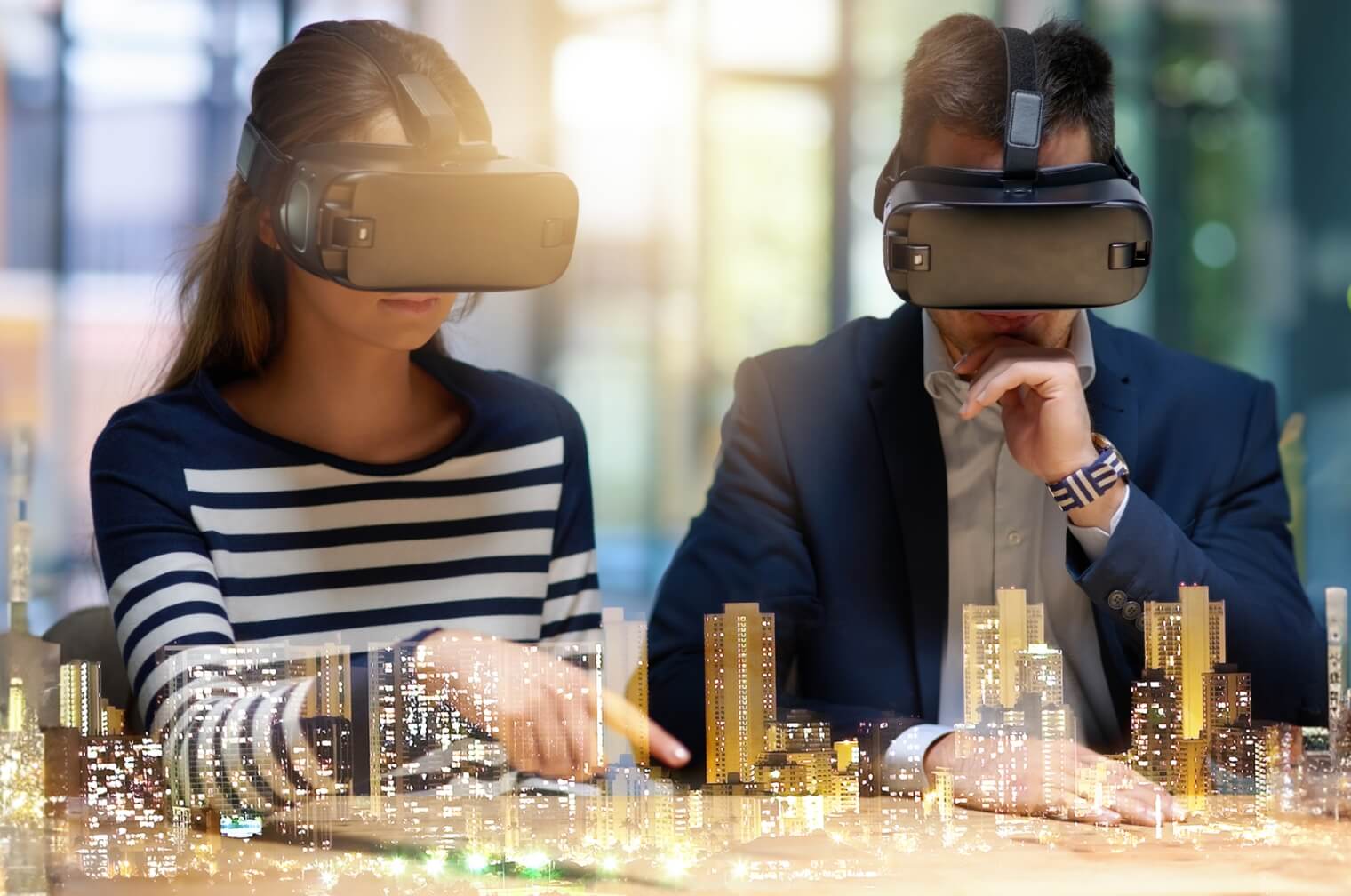Machine Learning and AI for revolution of Tech Companies are changing and streamlining businesses.
In the era of innovations, immersive technology is leading this with a promise of transformational experience.
At the very core, 3D immersive technology solution. Which is often referred to as Extended Reality (XR), includes Virtual Reality (VR), Augmented Reality (AR), and Mixed Reality (MR).
These technologies are blurring the lines between physical reality and virtual reality, as they provide us with a rich experience that once was only imaginable and not achievable.
Understanding Immersive Technology
Immersive technology XR (Extended Reality), offers a wide range of experiences, each with its unique blend of virtual and real-world elements. It includes three different categories:
Virtual Reality (VR): VR allows users to be completely transported in a digitally created environment, distancing themselves from the physical world completely.
This technology is usually accessed through a headset or goggles to be immersed in 360-degree digital experiences.
Augmented Reality (AR): AR overlays digital content onto the physical world, enhancing the user’s perception of reality.
It’s commonly experienced through smartphones, tablets, and AR glasses, enriching real-world environments with virtual elements.
Mixed Reality (MR): MR combines the best of both VR and AR, allowing users to interact with digital objects while still being aware of their physical surroundings.
This technology finds applications in industries where seamless integration of the virtual and real worlds is crucial.
History and evolution of Immersive Tech
The roots of immersive technology trace back to pioneering experiments in the mid-20th century, but it wasn’t until the late 20th and early 21st centuries that these technologies began to mature.
VR, for instance, emerged in the gaming and entertainment sectors before finding applications in fields like education, healthcare, and military training.
AR gained prominence with mobile apps and is now an integral part of navigation, gaming, and advertising. MR, on the other hand, is finding its stride in industries that demand intricate interaction between digital and physical elements.
Current and potential future applications in various industries
Immersive technology’s applications span across industries. In healthcare, surgeons use AR to guide complex procedures, while VR aids in pain management and therapy.
Education leverages these technologies for immersive learning experiences.
The gaming industry continuously pushes the boundaries of VR and AR. In architecture and real estate, prospective buyers can tour properties in 3D immersive environments.
Training and simulations are another fertile ground; industries like aviation and manufacturing use VR to train personnel for high-risk tasks.
3D Immersive Technology solution for business
In today’s rapidly evolving business landscape, staying ahead of the curve is imperative for survival and success.
One of the most revolutionary developments in recent years has been the integration of 3D immersive technology into various aspects of business operations.
From virtual reality (VR) to augmented reality (AR) and mixed reality (MR), these immersive technologies are reshaping the way companies engage with their customers, train their employees, and execute various business processes.
How businesses are integrating Immersive Technology?
Immersive technology is no longer a novelty but a strategic tool for businesses looking to thrive in the digital age.
Customer Engagement: Immersive technology has taken customer engagement to a whole new level.
Companies are using VR and AR to create immersive shopping experiences, allowing customers to visualize products before purchasing, leading to increased sales and reduced return rates.
Employee Training: Gone are the days of dull, text-heavy training manuals.
Businesses are using VR simulations for employee training, enabling them to practice real-world scenarios safely and effectively, ultimately improving performance and reducing training time.
Remote Collaboration: With the rise of remote work, MR technologies have become instrumental in enhancing remote collaboration.
Companies are leveraging MR headsets to conduct virtual meetings, collaborate on projects, and even conduct product design sessions with team members scattered across the globe.
Case studies of 3D Immersive Technology success
From virtual reality to augmented reality, these technologies have proven to be incredibly effective in a variety of industries.
Here are some case studies of 3D immersive technology success:
IKEA’s AR Furniture Shopping: IKEA’s mobile app allows customers to place virtual furniture items in their homes using AR, offering a realistic preview.
This has resulted in a significant increase in online sales and reduced returns due to mismatched expectations.
Ford’s VR Design Studio: Ford utilizes VR technology to design and refine new car models.
This has accelerated the design process and enabled engineers and designers to collaborate seamlessly in a virtual environment, saving time and resources.
University of Nebraska: The University of Nebraska Medical Center used virtual reality to train medical students on how to diagnose and treat sepsis, a life-threatening condition.
3D Immersive technology has been used to improve patient outcomes by allowing doctors and nurses to practice complex procedures in a safe and controlled environment.
Google’s Expedition Program: Google’s Expeditions program allows students to take virtual field trips to locations all over the world.
3D Immersive technology has been used to enhance the learning experience for students.
Advantages of Immersive Technology
Its application across industries is expanding rapidly, offering benefits that range from enhancing customer experiences to revolutionizing employee training.
- Enhanced Customer Experience: Immersive technology offers customers a more engaging and interactive experience, boosting brand loyalty and increasing sales.
- Improved Employee Training: VR and AR-based training programs are more effective, leading to quicker onboarding and better-skilled employees.
- Increased accessibility: Immersive technology can make content more accessible to people with disabilities. For example, virtual reality (VR) can be used to simulate experiences for people with mobility impairments or other disabilities.
- Cost-effective: Immersive technology can be a cost-effective way to create engaging content. For example, VR can be used to create virtual tours of real-world locations, which can be used for marketing or educational purposes.
- Enhanced creativity: Immersive technology allows creators to explore new ways of storytelling and content creation. It provides a platform for experimentation and innovation, which can lead to new and exciting forms of media.
Areas of application in business
Companies that embrace these technologies are poised to lead the way in their respective sectors, offering a glimpse into the exciting future of business operations.
- Retail: Virtual trial rooms, interactive displays, and immersive shopping experiences are transforming the retail sector.
- Manufacturing: VR simulations and MR tools are improving product design, prototyping, and quality control processes.
- Healthcare: Surgeons use VR for surgical planning, and medical professionals use AR for patient data visualization.
- Real Estate: Virtual property tours and AR apps for property visualization are changing the way real estate is marketed.
Future of Immersive Technology in business
In the fast-paced world of technology, staying ahead of the curve is essential for businesses.
As we step into the future, the landscape of immersive technology in business is set to undergo groundbreaking changes.
Predictions for the future of Immersive Tech
Below are the listed predictions for the foreseeable future of immersive technology.
- Mainstream Adoption: Immersive technologies like augmented reality (AR) and virtual reality (VR) are poised to become household names, integrating seamlessly into our daily lives. This includes everything from shopping experiences to remote collaboration.
- Enhanced Customer Engagement: Businesses will increasingly leverage immersive tech to create unique and interactive customer experiences, enhancing engagement and brand loyalty.
- Education and Training: Immersive technology will revolutionize education and training, offering realistic simulations for hands-on learning, from medical procedures to flight training.
Emerging trends and technologies in the immersive space
Below are some of the top Immersive Tech Trends:
- Metaverse: The concept of the metaverse, a shared digital universe, is gaining momentum. Companies are investing heavily in creating interconnected virtual worlds that offer limitless possibilities for work, play, and socializing.
- 5G Connectivity: The rollout of 5G networks will provide the high-speed, low-latency connection required for seamless immersive experiences, enabling more widespread adoption.
- AI Integration: Artificial intelligence (AI) will play a pivotal role in personalizing immersive experiences, and adapting content in real-time to user preferences.
- Haptic Feedback: Innovations in haptic feedback technology will make virtual experiences feel even more real by providing tactile sensations.
How businesses can prepare for the next wave of innovation
To prepare for the next wave of the Immersive Tech Trends, Businesses should keep the following points in mind.
- Stay Informed: Keeping your head wrapped around emerging technologies and trends in the immersive space is crucial. Stay informed with regular updates and network with experts in the field.
- Experiment and Adapt: experiment with different immersive technology solutions. Pilot projects and prototypes can help you understand how these tools can benefit your business.
- Invest Wisely: Allocate resources strategically to develop or implement immersive solutions that align with your business goals.
- User-Centric Approach: Prioritize user experience. Ensure that immersive experiences add value and are intuitive for customers and employees alike.
- Security and Privacy: As immersive tech collects more data, prioritize security and privacy to maintain trust among users.
Conclusion
The future of immersive technology in business is filled with exciting possibilities.
As it becomes more integrated into our lives, businesses that embrace and adapt to these changes will be better positioned to thrive in the digital frontier.
Keep your eyes on the horizon and be ready to immerse yourself in the future of business technology.
Frequently asked questions
Immersive Technology includes different technologies such as Virtual Reality (VR), Augmented Reality (AR), and Mixed Reality (MR).
The future of immersive technology solutions offers multiple benefits such as enhancing customer experience, revolutionizing employee training and development, remote collaboration and communication.
Immersive technologies like AR and VR are offering virtual tours for product exploration, reducing risks with VR simulations, boosting engagements, and improving decision-making.
There are several types of immersive technology solutions. Some of the different types include Virtual Reality (VR), Augmented Reality (AR), Mixed Reality (MR), 360-degree Video, Haptic Feedback, Spatial Computing, etc.
To implement 3D immersive technology in your business, you can follow these steps:
- Identify your business needs
- Research available technologies
- Set clear goals
- Develop a strategy
- Collaborate with experts
- Pilot projects
- Train employees
- Monitor and evaluate
- Scale up
- Stay updated









